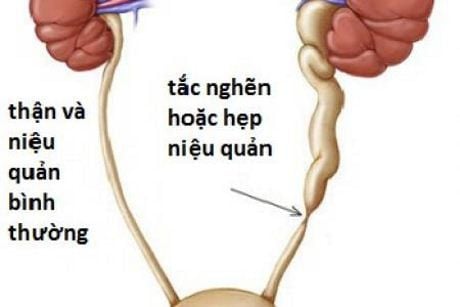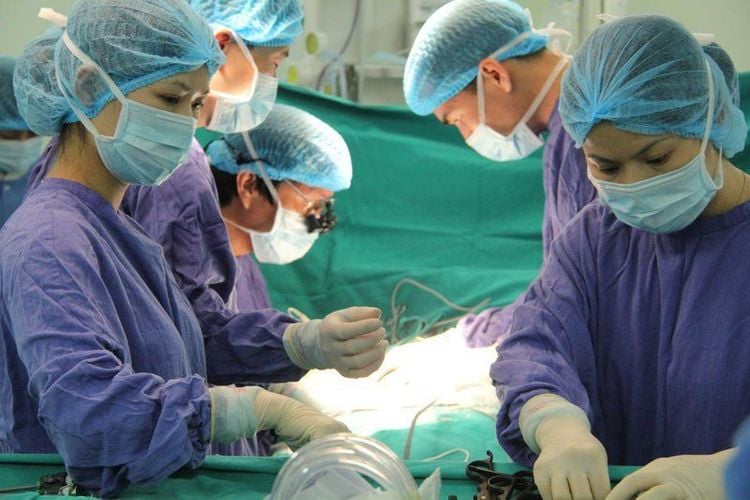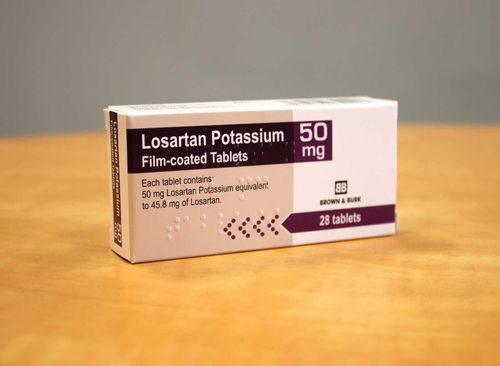This is an automatically translated article.
Narrow ureteropelvic junction is a birth defect that obstructs the junction, obstructing the flow of urine from the renal pelvis to the ureter, leading to hydronephrosis. Currently, the most commonly chosen treatment for narrowing of the pyelonephritis-ureteral junction is laparoscopic surgery to remove the pathological junction, and to shape the pyelonephritis-ureter to help expel urine from the ureter. kidney to the ureter better.
1. Overview of narrowing of the pyelonephritis - ureter
Pelvic-ureteral junction stenosis is a partial or complete obstruction of the place where urine is produced (kidney) and the tube leading to the bladder (ureter) through the junctional tube and normally it is blocked in the renal pelvis . The kidneys filter the blood and store urine at its center, where the pelvis sends water into the ureters so it can travel to the bladder. Narrowing of the pyelonephritis-ureteral junction causes urine to be obstructed and accumulates in the kidneys leading to hydronephrosis and damage to the kidneys.
Most pyelonephritis-ureteral stenosis is congenital and it is also the most common cause of their hydronephrosis detected on prenatal or neonatal ultrasonography. This blockage can cause mild to severe illness. Mild cases usually do not damage the kidneys or impair kidney function, but can lead to urinary tract infections in children. In severe cases, it can cause significant damage to the kidneys.

Thận, niệu quản bình thường và thận, niệu quản bị tắc
Accordingly, narrowing of the pyelonephritis - ureter often has signs or symptoms such as hematuria (blood in the urine), urinary tract infection, kidney infection, kidney stones. The disease can be treated by conducting laparoscopic surgery to narrow the pyelonephritis-ureteral junction. This is a less traumatic method than the traditional method. At the same time, it helps patients recover quickly, reduce the risk of surgical site infection and have high aesthetics.
2. Laparoscopic surgery to treat narrowing of the pyelonephritis-ureter junction
To perform surgery to treat pyelonephritis-ureteral stenosis, the doctor will perform a clinical examination to give an indication to proceed. Indicated cases for performing this surgery are recurrent pyelonephritis-ureteral stenosis after pyelonephritis - ureteroplasty failure, recurrent pyelonephritis - endotracheal stenosis after stone surgery, narrowing of the ureter. pyelonephritis-endotracheal connection but the general condition does not allow pyelonephritis - endotracheal surgery (both open surgery and laparoscopic surgery)
The patient's indicators are checked before participating in the surgery. Intravenous urography, computed tomography and tests to evaluate kidney function. It is important for the patient to have any urinary tract infection or systemic illness cleared up before surgery.
Before each surgery, in addition to preparing the patient, equipment, operating room, and surgeon, the preparation of records is extremely important. It includes: minutes of consultation, minutes of surgery approval, medical record, pre-anesthesia and written commitment of the patient's family.

Mổ nội soi điều trị hẹp khúc nối bể thận-niệu quản là phương pháp ít sang chấn hơn so với phương pháp truyền thống
2.1. The procedure of laparoscopic surgery to narrow the pyelonephritis-ureteral junction
The patient was given endotracheal anesthesia, spinal anesthesia, and epidural anesthesia. After that, the appropriate position is adjusted (obstetric position). The surgeon will thread the guide and the endoscopic tube to the narrow junction. Then, using a laser or cutting tool to cut the narrow junction, followed by inserting the endoscopic tube and guide into the renal pelvis. Finally, a double J catheter will be inserted as the catheter, a full examination will be performed, and a urinary catheter will be inserted.
2.2. Follow up after surgery and handle complications
After pyelonephritis - ureteroplasty surgery to treat narrowing of the pyelonephritis - ureter, the patient will be monitored for endotracheal perforation. If this situation is encountered, it can be corrected by the surgeon performing the surgery gently, carefully identifying the clamp, and making an incision of the narrow ureter. Besides, it is also necessary to monitor the patient for endotracheal bleeding. If this is the case, it is important to determine if there is an abnormal blood vessel and possibly switch to open surgery if necessary.
Laparoscopic surgery for narrowing of the pyelonephritis-ureteral junction may have complications such as urinary leakage after surgery (reposition of the ureteral catheter) or urinary tract infection (treatment with antibiotics).
Laparoscopic surgery to treat ureteral junction stricture can leave dangerous complications, so patients need to choose well-qualified hospitals that can examine, treat, and at the same time. It is possible to treat complications immediately if there are dangerous complications affecting the patient's health.
Vinmec International General Hospital is the address for examination, treatment, prevention, screening and screening of urological diseases, bringing good results to satisfy many customers. With a team of qualified, well-trained doctors and medical services, it will minimize complications during and after surgical treatment.
To register for examination and treatment at Vinmec International General Hospital, you can contact Vinmec Health System nationwide, or register online HERE.
MORE:
Surgical treatment of narrowing of the pyelonephritis - ureteral junction Narrowing of the ureteropelvic junction in children: Need to be detected early in the pregnancy period in the womb What is hydronephrosis?













